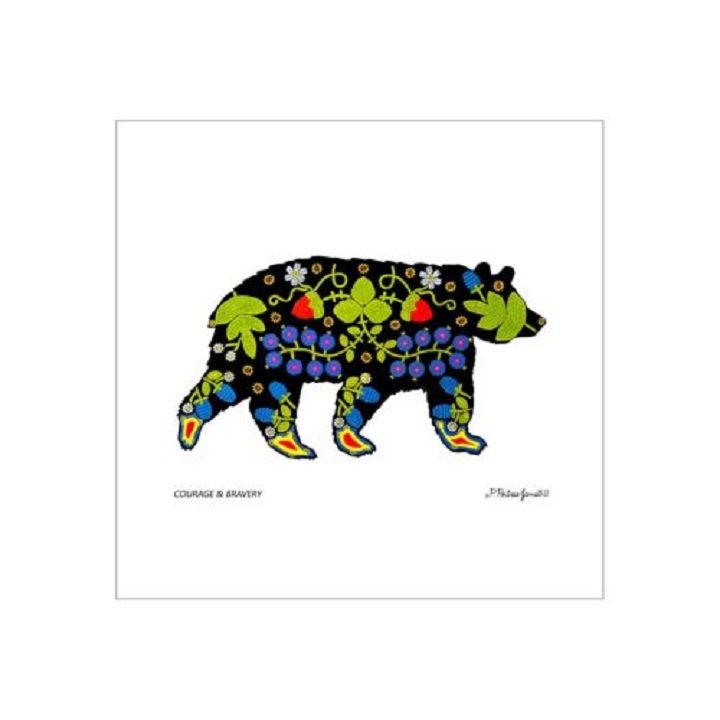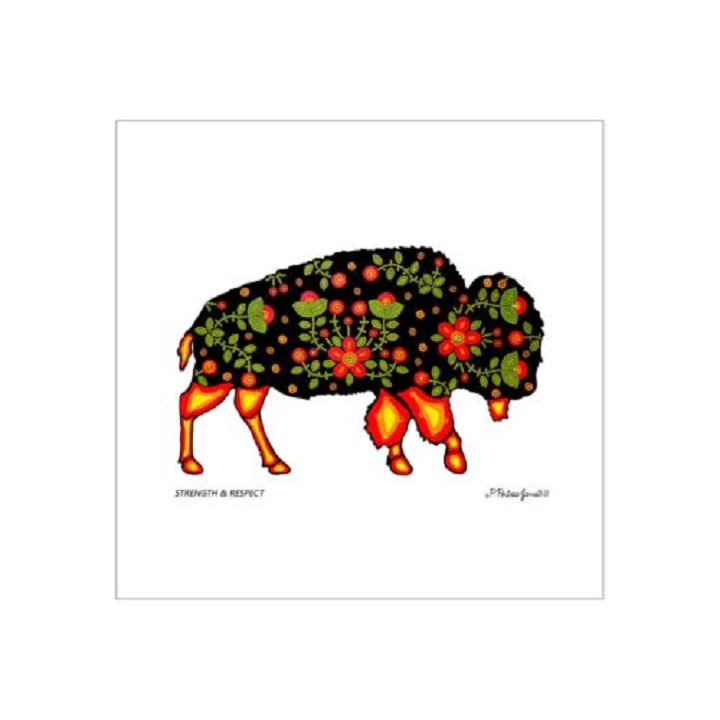Spirit Animals: Finding harmony within ourselves and with nature
April 20, 2022

Phyllis Poitras-Jarrett is a contemporary Métis artist from Saskatchewan, Canada who uses her artwork to remind us about the interconnectedness of all things in the natural environment.
She communicates through the medium of mixed materials, paint, and intricate beadwork in the traditional floral style of the Métis peoples.
“Historically, Métis women have always beaded. First they were taught to embroider, but when glass beads were introduced, they transferred the symmetry from embroidery into their beadwork,” Poitras-Jarett said.
“I knew I wanted to do beadwork, most beadwork with my kokum (grandmother) she taught me.”
The colours and patterns she uses give her artwork a unique style.
As Poitras-Jarrett explains, “Métis beadwork celebrates flora and fauna within nature” and it helps us to realize how important it is to maintain the natural balance we observe in our surrounding environments.
In her ‘Spirit Animal’ collection, Poitras-Jarrett uses animals and symmetrical floral beadwork to represent an Indigenous perspective that we should have respect for all living things.
“Each animal represents a basic human value.”

For example, the buffalo represents the values of strength and respect, the wolf represents being mindful and humble, and the beaver, creativity and wisdom.
Poitras-Jarrett said, “it is important to remember these human values, because sometimes people focus too much on themselves, too focused on buying things.”
By connecting with these values, it helps us move away from selfishness and consumerism, and instead turn our focus to the actions and values needed to maintain a healthy relationship with the land we live on.
As the natural environment changes at a rapid rate, it’s often Indigenous peoples who feel the changes significantly. For example, in northern Canada, as permafrost melts and shifts, infrastructure is at risk in many Indigenous communities.
Caretakers of the land for millennium, Indigenous peoples lived in balance by never taking more than they needed and giving the land time and space to regenerate. Taking more and more from the land disrupts the natural balance and expedites the impacts of climate change.
Poitras-Jarrett draws her inspiration from the natural world around her. Growing up on a farm near a lake in Saskatchewan, Canada, she reveled in the beauty of the landscapes and from a young age had a curiosity for the animals around her.
“I always loved nature and animals on the farm. I’d take long hikes searching out these animals,” she said.
However, over time, those landscapes are changing due to climate change impacts on the environment.
“We are forgetting that knowledge of being connected to nature… there are now way more forest fires, more smoke-filled polluted air – it’s out of balance,” said Poitras-Jarrett.
This effect has been seen in Canada and abroad, including Australia.
With increasing bush fires and loss of natural habitat for a variety of unique species, non-Indigenous people are recognizing the importance of Aboriginal land management practices used for thousands of years.
When asked about how it may connect with Aboriginal and Torres Strait Islander peoples in Australia she said, “we are all connected, we all feel the same way, we all feel similar values, every human being has these values within themselves.”
“The art seems to be a form of healing because Indigenous peoples are so close to nature. It’s always been part of our lives, and to see it and have art in your house is special. I didn’t realize how touching the descriptions and beadwork and animals would be to Indigenous people across Canada… they really appreciate it.”
The Canadian High Commission in Australia is bringing this artwork to Australia to showcase in an upcoming event for World Environment Day in June.
Poitras-Jarrett’s art has a message of hope and determination by representing the healthy balance that can be achieved by looking beyond ourselves.
“It celebrates nature and how important the natural world is to all Indigenous peoples.”
It also stands as an important reminder in our current climate emergency. In looking beyond ourselves and restoring balance in the natural environment, will not only help achieve a more environmentally sustainable future, but also help restore the balance amongst our own lives and selves.
The ‘Spirit Animal’ collection will be complete at 30 paintings. She has completed 24 paintings so far with 6 more to do. When asked if she has a favourite she admits, “each time I paint one, that one is my favourite.”
Written by Amy Smith
Amy is a Métis woman from Edmonton, Alberta in Treaty 6 territory in Western Canada, currently living on the lands of the Ngunnawal and Ngambri peoples in Canberra, Australia.
Amy has worked in the Indigenous space in both Canada and Australia, including for the Canadian federal government, Indigenous organisations and the university sector. She is now a Senior Reconciliation Action Plan (RAP) Officer with Reconciliation Australia.
- Date modified: